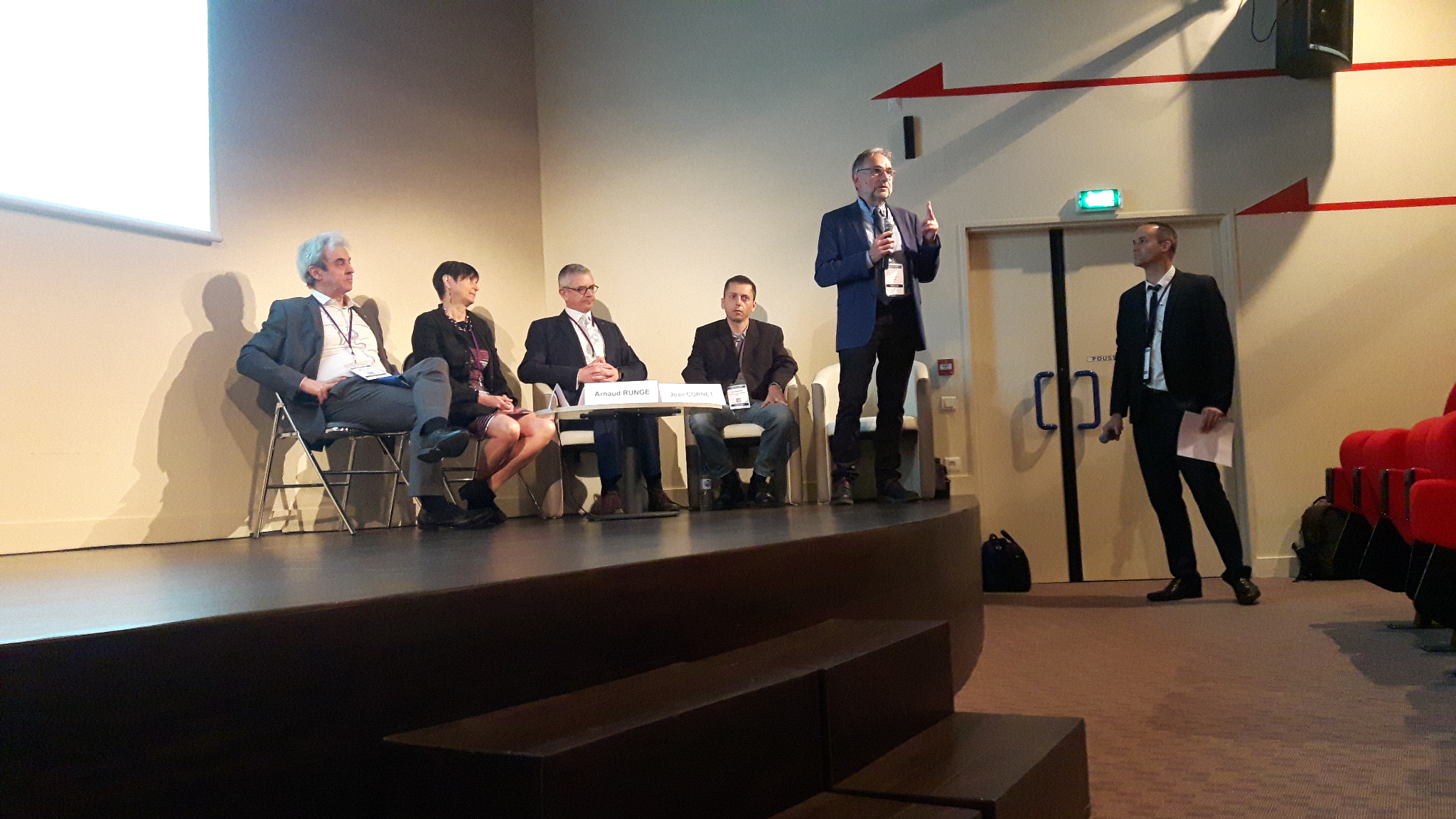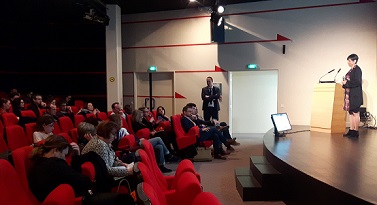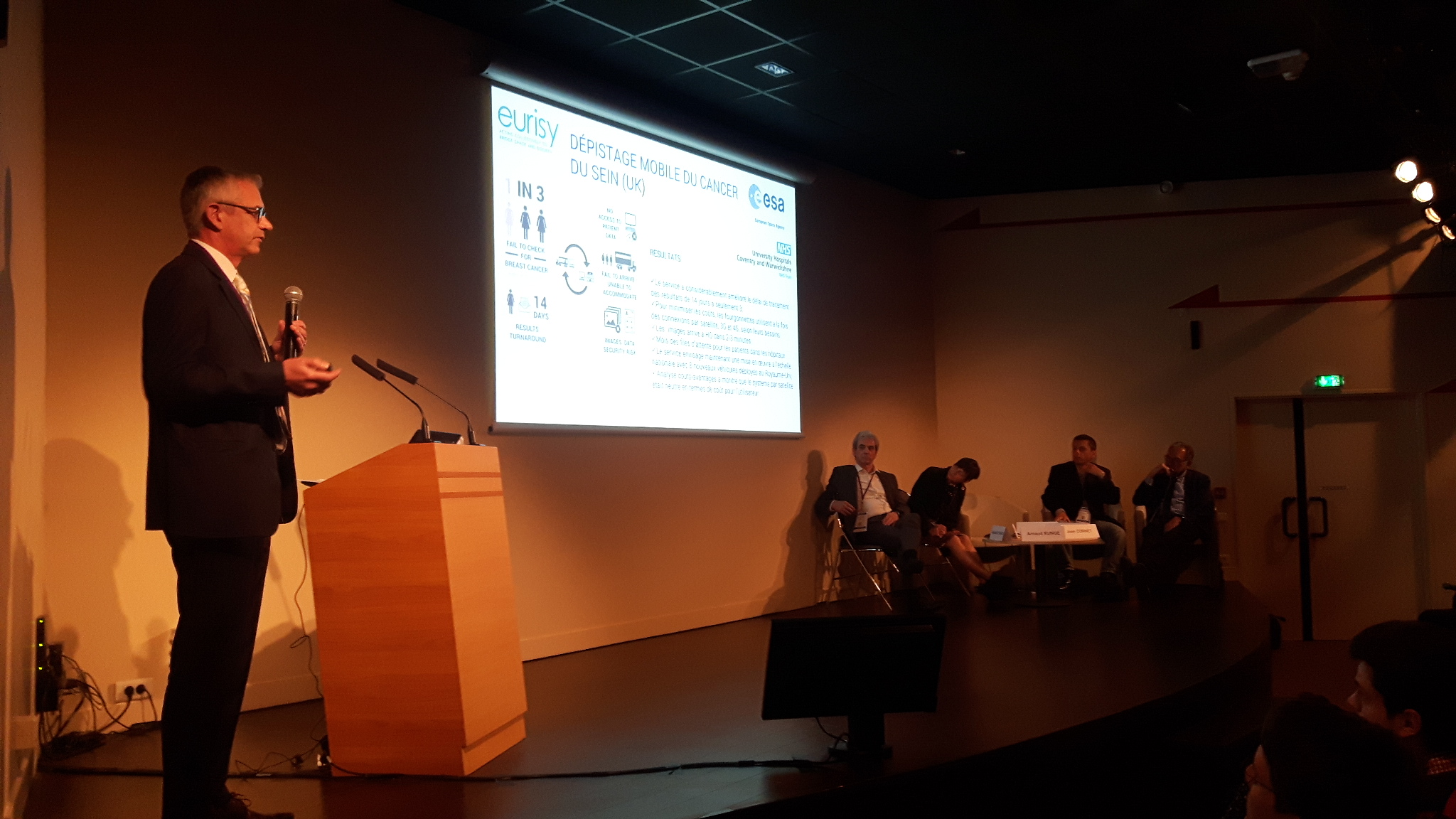POITIERS, FRANCE – France’s technology themed park Futuroscope was home to the first edition of “Pro Digital Health” Congress organised by Agir pour la Telemedicine and CREAI Nouvelle Aquitaine on 4-5th April, 2019. Dedicated to healthcare professionals, the event featured a 360-degree program of exchanges between practitioners, policy makers, industry and startups on how best to meet present and future healthcare challenges in France. Telemedicine services were at the heart of the programme – as parts of such services have recently become reimbursable in France.
To introduce how space can aid make e-health services accessible to all and take medical services beyond hospitals, we brought together our members at CNES and the European Space Agency (ESA) and our partners at MEDES and the European Connected Health Alliance to share their hands-on examples and best practices.
An ageing population and a parallel rise in chronic disease, unequal quality and access to healthcare, shortage of health professionals and spiralling costs – Europe’s health care sector is increasingly facing multiplied challenges at the cross-roads of separate, but interconnected, trends. Among these, digital trends are pushing a sector that is known traditionally as being highly regulated and complex. To lay the scene, Joan Cornet, Director of the Digital Health Observatory at the European Connected Health Alliance highlighted what are, in his view, the main digital healthcare transformation trends. From telemedicine fast becoming a necessity, to the Internet of Medical Things (IoMT) irruption in the market, Artificial Intelligence, Big Data Analytics and Robotics, to name a few, these trends have far-reaching implications for the healthcare sector and patients alike.
For healthcare practitioners, navigating this new digital landscape can prove a daunting enterprise. And we don’t blame them. With so many options available how does one choose the best one for them? Moreover, adding new services to existing infrastructures and work flows can be perceived as a time-consuming task by healthcare professionals. They already struggle with brimming agendas and long patient lists. On top, the spread of e-health technologies is likely to accelerate a blurring of lines of responsibilities among medical professions. In turn, this will also require them to obtain additional skills and digital competences previously restricted to tech-savvy sectors.
To successfully tackle these changes, Mr Cornet underlined the importance of creating communities of knowledge and practice where healthcare sector stakeholders can come together to exchange, learn and build trust. For professionals and patients alike, mistrust in new tech, together with potential gaps in digital competencies and/or infrastructure are only adding to their reluctance to take-up new services – be they satellite powered or not. And despite the numerous opportunities provided by new technologies, sociological and organisational barriers continue to remain strong within the sector.

To answer to this need for trust-building, ECHAlliance has, as of 2011, been working on establishing a global network of ecosystems. Regionally-focused, such multi-stakeholder partnership-based structures aim to work together to implement innovative solutions that improve the quality of healthcare services for citizens and health professionals. In addition, the organisation has also set up a Digital Health Observatory of good practices “because the only way to overcome our personal limits is to share knowledge” Mr Cornet added.
Space based solutions can be part and parcel of the technology mix fuelling these new applications in healthcare. Whether they are addressing planning, e-learning, prevention, early warning or health-care delivery, numerous applications and technologies have been successfully tested in recent years.
Acknowledging the numerous benefits of such applications, the sector seems to suffer however from a serious case of ‘pilotitis’. ESA representative, Arnaud Runge, acknowledged that despite the large number of projects that have been supported by the Agency in Europe and elsewhere, few services have reached a status of operational continuity. “A pure technology demonstration approach proved insufficient without user driven demand and equitable risk sharing”, Mr Runge argued. Shifting perspective in the last decade, ESA has now been looking to contribute to the development of space-based health applications market by creating products and services in partnership with industry and users – so that these respond to existing needs and challenges. In addition, by adopting a co-funding model (rather than a subsidies based on) ESA aims to steer service providers towards achieving independent sustainability faster.

Different users, have also different needs. Needs that can vary not only across the sector itself, but also between national, regional and local policies and practices. Navigating such diverse needs in a labour intensive, complex system such as healthcare, is not an easy task. That’s why adaptability lied at the heart of the mobile telemedicine units developed by CNES and MEDES- DIABSAT and TIMM.
Having been deployed in the Occitaine region since 2010, DIABSAT has helped diagnose diabetes related complications for 3286 diabetic patients over 442 days. Conducted and operated by a nurse, the satellite connected van, has been a successful solution for the Regional Health Agency to address their “healthcare deserts” challenge and take services “beyond hospital walls”.
Although France enjoys a reputation for having one of the world’s best healthcare systems, it has an aging population and a shortage of doctors, especially in rural areas. While DIABSAT is specifically equipped for medical examinations related to diabetes complications, ”it can be tailored to respond to a variety of medical specialities” MEDES’s Olivier Tournebize argued. Following DIABSAT’s model, the TIMM unit provides more advanced medical tele-imaging and teleconsultation services such as radiology, ultrasound, mammography or dermatoscopy consultations – satellite connected, anytime, anywhere. Similar projects have also been developed in the UK as part of prevention strategies for breast screening and colonoscopies, as well as for monitoring patients with diabetes complications.
France’s medical deserts are far from being an isolated case in Europe. Like in many developed countries, a system in which healthcare provision is arranged around hospitals, finds itself in need to adapt to social changes and patient expectations. Contrary to other EU members, France is however paving the way in terms of legislation which (as we argued in a previous report), can play a critical role to either hinder or enable the scale up of e-health solutions (once again, be they satellite powered or not). As of October 2018, after 10 years of feasibility studies, telemedicine consultations can now be legally covered by both public and private healthcare providers. A much awaited legislative change, according to experts present at the Pro Digital Health event. With France’s steadily increase in elderly population, demand for such services is expected to grow exponentially in the medium and long term (the share of the population over 65 years old has increased in France from 18.8% in 2016 to 19.6% in 2018) (1).
Telemedicine has also proven a reliable solution for France’s overseas departments and territories. The French Guyana is defined by vast wilderness and its low population density. Here, satellite connected telemedicine services have been a vital tool to provide medical services and epidemiology monitoring to isolated communities. The telemedicine network which was set up in 2001, still serves some of the department’s centres today. In 2018 alone, over 60,000 consultations were conducted using a telemedicine service across 18 delocalized prevention and care centres.
To facilitate the use and integration of satellite communication based solutions, CNES with initial support from Midi-Pyrénées Region and Toulouse Métropole, has set up the CESARS Expertise Center. The assistance center, who’s operation is fully supported by CNES today, is tasked with providing advice to SMEs and public authorities facing connectivity challenges. As such, with the center’s support, interested parties can look into whether adding a satellite communication link would respond to their needs and improve their services, no matter the domain. According to Ms Sandrine Lafont from CNES, “any entity can benefit from the center’s council for ten days at no cost“.
When it comes to scalability, the cost of such services was one of the main concerns expressed by experts in the audience. Thus, perceptions pegging satellites to expensive services, remain widely spread amongst the general public. Despite the dropping costs for satellite communication services and the proven effectiveness of demand aggregation and resource pooling approaches, such perceptions are sometimes hard to shake. When in reality, satellites can actually provide a cost-efficient solution to cases where terrestrial communications are not set up or temporarily out of order (e.g. for occasional teleconsultations, as well as for urgent tele-expertise for cerebrovascular accidents).

Cost is not the only concern that needs tackling for users. So is the question of interoperability of telemedicine systems, and new technologies in general, with existing infrastructure, training needs and coordination between service providers. These and certainly many other aspects, together with tackling misconceptions surrounding space as being a completely remote actor from the medical sector, will still need the space sector’s attention. Yet, we are already a step forward as an important legislative bottleneck preventing businesses from setting up successful telemedicine solutions based on satellite connectivity was removed. Now, other EU members need to follow.
For many participants, the potential of space applications and their affordability was a positive discovery, with many feeling encouraged to obtain more guidance on available solutions and services. Thus, showing there is (still) a constant need to bring space closer to users. To go where they are and bring their challenges forward. Going from space to society and back, hands-on products presentations were complimented by a trip inside the International Space Station’s medical facilities guided by ESA Astronaut Leopold Eyharts.
